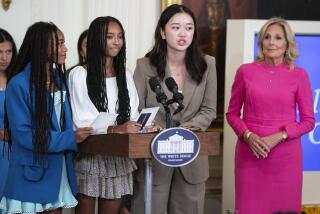First Lady Wants Students on Best Behavior
- Share via
BALTIMORE — When her husband announced the Helping America’s Youth initiative during last week’s State of the Union address, Laura Bush found herself with a new role -- heading up a $150-million program.
Though the onetime teacher and librarian has gone to schools to promote such administration policies as No Child Left Behind, the first lady’s visits are now related to a program of her own that aims to reduce violence and gang activity among at-risk youth, especially minority boys.
On Tuesday, she appeared at George Washington Elementary School in Baltimore, where she spoke to 100 students, teachers, community activists and state officials about the relationships among classroom management, behavior, learning and success.
“Research shows that children who are overly aggressive as early as the first grade are at a greater risk for delinquency, dropping out of school, drug abuse and depression later in life,” Bush said. “Here in the Baltimore public school system, children with behavioral problems in poorly managed first-grade classrooms were up to 20 times more likely to be severely aggressive in middle school compared to similar children in well-managed first-grade classrooms.”
She cited one of the school’s approaches to teaching proper behavior -- the “good behavior game” -- as a model for keeping children in school.
Shortly before her noontime speech, Bush observed a first-grade class engaged in the game during a reading lesson. The children were divided into teams, and any child who acted out while the class completed an exercise would get the entire team a check mark for bad behavior.
As Bush moved among the students, asking them to pronounce words on their papers such as “nose” and “stream,” not one child spoke out of turn. Instead, they focused their attention on sorting words into categories and winning the game for their team.
“This team-based structure uses peer encouragement to help children follow rules and learn how to be good students,” Bush said. “The students quickly learn that their success is tied to their team.”
The game is part of a program created by Dr. Sheppard Kellam, a senior fellow at the American Institutes for Research, called “Whole Day First Grade.” Introduced 20 years ago in 24 Baltimore schools, the program focuses on improving educators’ teaching and classroom management skills, and communication with families.
“The risk factors that Mrs. Bush has referred to -- early aggressive disruptive behavior -- are highly correlated with academic achievement,” Kellam said Tuesday.
In her remarks, Bush noted that according to Kellam’s research, 86% of at-risk youth who participated in the Whole Day program graduated from high school, compared with 19% of those who did not.
Kellam said government at all levels needed to respond if programs like his were to move across the country.
“When you include the city, then the state, then the federal government and the first lady to lead the way, [you] have real multilevel support,” he said. “We better keep this up, because that’s the model that’s going to win, moving outward across the country.”
Teachers at the school were hopeful that the first lady’s new policy role would encourage children to stay in school and away from gangs.
In this urban school surrounded by blocks of burned-out and boarded-up row houses, visits from political figures are rare, said Monique Daniel, a fifth-grade teacher whose students heard the speech.
“This is not something [students] usually encounter in their everyday lives, to see the president’s wife speak in reference to students,” Daniel said. “Maybe it will show them that someone besides their teachers and parents does care about them and their future.”
Fifth-grader James Gilbert, 11, said, “She doesn’t want people to drop out of school, so you can learn and get an education and you can get a good job.”
More to Read
Sign up for Essential California
The most important California stories and recommendations in your inbox every morning.
You may occasionally receive promotional content from the Los Angeles Times.










